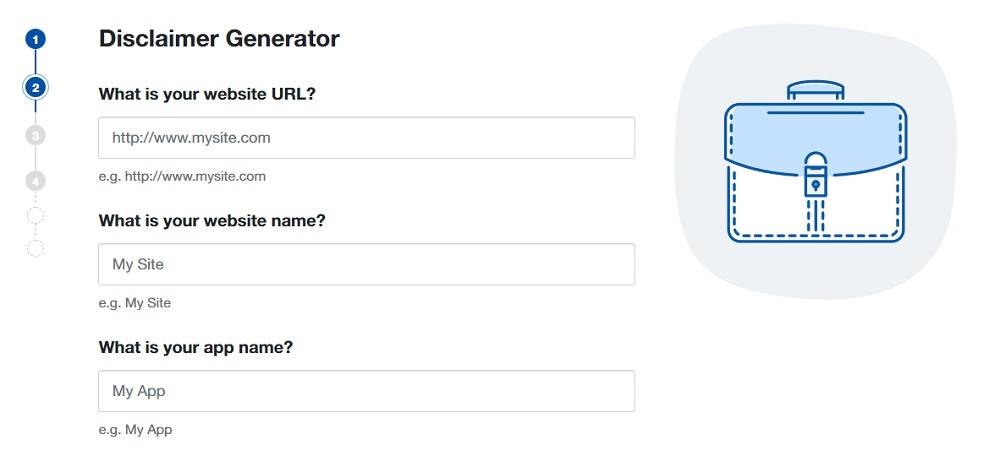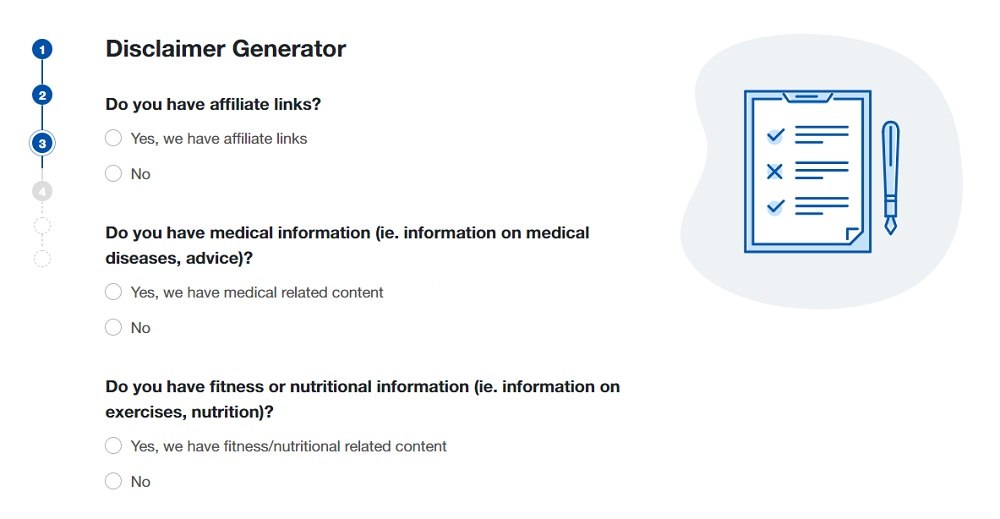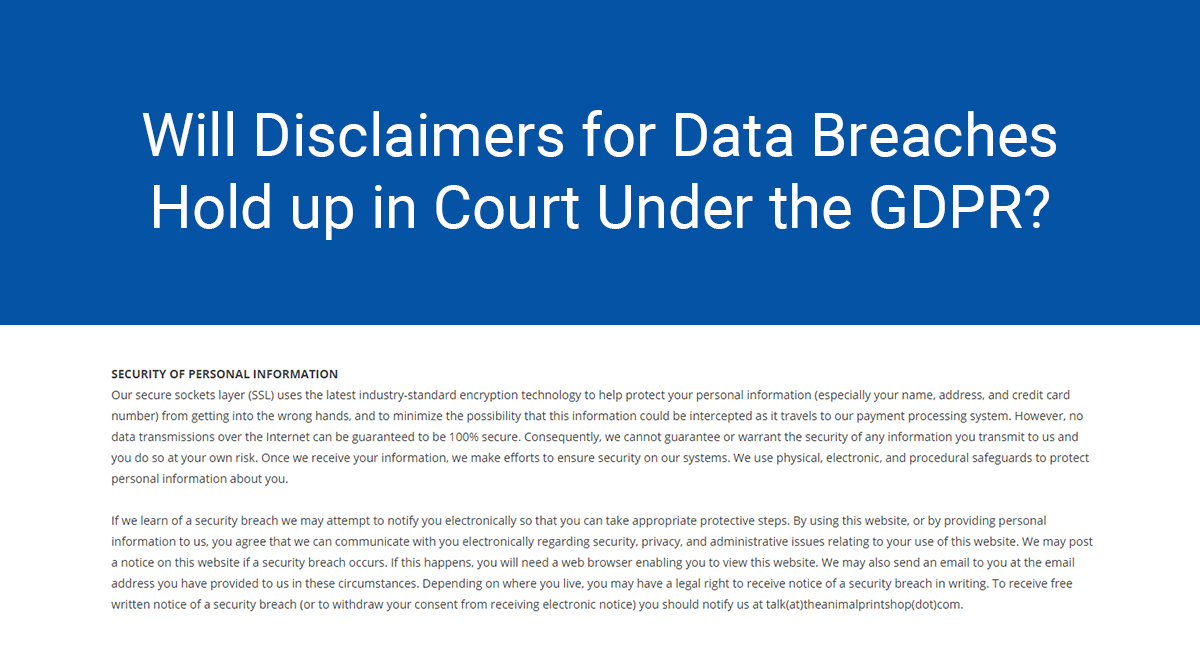There is some dispute over whether disclaimers are legally binding. Much of this arises from the way they are presented. Disclaimers are often not treated like contracts or legal agreements which makes them more difficult to enforce if you face legal issues.
You can improve this situation by treating your Disclaimers the same way you treat your Privacy Policy and Terms and Conditions (T&C).
Privacy Policies are often conspicuous because most nations require them, while T&C's are highly recommended - not legally required. However, they contain rules and enforcement measures that are instrumental to your business. Also, users are familiar with seeing these agreements.
Disclaimers are similar.
Here is how to treat them more seriously so they are more likely to be legally binding.
Our Disclaimer Generator can generate a legal disclaimer for your business, website or mobile app. Just follow these steps:
-
At Step 1, select where your Disclaimer will be used.

-
At Step 2, add in information about your website/app and business.

-
Answer some questions about your business practices.

-
Enter an email address where you'd like to receive your Disclaimer and click "Generate."

Done! You'll be able to instantly access and download your new Disclaimer.
Regarding Disclaimers
Disclaimers have existed for as long as there have been laws. While T&C's contain general liability waivers, Disclaimers address specific issues with your product or service.
Disclaimers may cover medical or health risks, professional liability and earnings claims. If your website or app creates a risk of user error or misuse, a disclaimer will do more to help you than hurt you.
However, you need to approach them in the same way as you do with a T&C if you want them to be enforceable.
Are Disclaimers contracts?
To create a contract, there must be an offer, acceptance of that offer, and payment or consideration to close the transaction. Each party has an obligation to the other and most contracts are in writing - especially when the transaction is commercial.
While there is normally negotiation when creating contracts, that is not the case with online agreements. Users have access to your T&C and Privacy Policy, for example, but they cannot demand that you change terms before they accept your service. After reviewing these documents, the user has the choice to create an account or refuse to go forward.
Even without this negotiating power, there is little dispute about whether T&C and Privacy Policies are contracts. They are generally accepted as enforceable contracts. However, the situation is less straightforward when it comes to Disclaimers.
Developers often include Disclaimers in their T&C. Since these terms are accepted at the time a user creates an account or buys an item, the Disclaimer is enforceable.
The most common Disclaimer found in a T&C is the general Warranty Disclaimer, like this one provided by Amazon:

Since it is a general disclaimer and not related to specific liability or substantial risk, this is adequate protection for Amazon. However, there are situations where a specific Disclaimer is more appropriate.
iHerb sells health products which could be mistaken for medical advice. Rather than risk the liability of misdiagnosed conditions or inappropriate health decisions, iHerb offers this specific Disclaimer stating that it does not provide professional medical advice and customers need to consult their health providers before relying on supplements:

"Use at Your Own Risk" is another common Disclaimer. Concept2 provides exercise equipment which can injure customers if used incorrectly. With a page dedicated to Disclaimers, it includes this sentiment:

Other Disclaimers are required by laws requiring truthful advertising. This includes Earnings Disclaimers which inform users that a money-making strategy depends on their effort and is not necessarily guaranteed.
Income Diary provides this example:

By themselves, Disclaimers serve as a warning to users. They give users realistic expectations for a product or service. However, that is often not enough to guarantee legal protection.
To enjoy the legal protection offered by Disclaimers, you need to make sure users accept them just as they accept your T&C and Privacy Policy.
Making Disclaimers legally binding
Your Disclaimers can be legally binding as long as they are not unfair and users can review them.
There are two ways to assure this.
One is to make your Disclaimers part of the T&C . Since users must accept those terms when they sign up for your service or make a purchase, that makes the Disclaimers a part of an already enforceable contract. You may want to give them a separate section in your T&C so they are more conspicuous.
The second way is to place the Disclaimer on your website as a separate document with its own link in the footer. You can link to it from your T&C or even make acceptance of it part of the sign-up or purchase process.
Unfortunately, many websites post Disclaimers without providing links or bringing them to a user's attention. If you follow this pattern, you risk having a court consider your Disclaimers ineffective. That is why you need to fine-tune how you make them available to users and how users accept them.
Assuring acceptance
For any agreement to be considered accepted there must be:
- Notice to the user
- Consent from the user to be held to the terms, and
- Fair terms
These elements are present with most Privacy Policies and T&C's. You can also apply them to Disclaimers. The problem that often arises is that while Privacy Policies and T&C benefit from clickwrap, Disclaimers are still presented via browsewrap and do not require affirmative consent from the user.
Disfavor of browsewrap
Browsewrap is a reference to the old shrinkwrap licenses on software packages. It assumes that T&C's, license agreements, and Privacy Policies are accepted just because the links are available and a user accesses a website or app.
Most websites add links to their agreements in their footer. This is the one for iHerb:

However, while iHerb has a separate Disclaimer it does not offer a link to it in the footer. Even if it wished to argue that the Disclaimer was accepted via browsewrap, that is unlikely to prevail because there is no conspicuous link to it. The Disclaimer acts merely as a warning and may not be legally binding.
Even when there is a link, browsewrap alone is often considered inadequate. Specht v. Netscape arose in the early days of the Internet.
In this decision, the court rendered a T&C unenforceable because the user was not informed of it and was not given a chance to accept or reject it. This decision created an early precedent where developers must be forthright with their T&C.
Yet, when a company used browsewrap while also providing notice of the agreements, the court rendered it enforceable. In Hubbert v. Dell, the repetitive showing of "All sales are subject to Dell's T&C of Sale" with a hyperlink was considered adequate notice.
Basically, passive acceptance through the mere presence of agreements is not preferred. Active acceptance through clickwrap is quickly becoming the standard and the best way to avoid these issues.
Effective use of Clickwrap
Unlike browsewrap, clickwrap requires direct participation from users. When signing up for an account, users are informed that clicking the "submit" button constitutes agreement with the terms, or they must check a box to indicate they accept the terms.
A recent case in the U.S. demonstrates the effectiveness of clickwrap combined with clear app or website design. In Meyer v. Uber Technologies, Inc., users sued Uber on the basis of price fixing. Uber filed a motion to compel arbitration as stated in its Terms of Service. Users argued that the arbitration provision was not enforceable because they did not have the opportunity to access that document.
The court determined otherwise. Uber's sign-up page makes it clear that creating an account shows agreement with the terms. That dialog also included links to the Terms of Service and Privacy Policy. Users were held to those terms even if they did not review the documents. The court considered it enough to enforce the arbitration provision that the agreements were accessible.
This is the sign-up page discussed in the lawsuit and considered adequate by U.S. courts:

This is not the only area where Uber advances affirmative consent. Since "surge pricing" has the potential to create lawsuits, it handles that issue much like a Disclaimer.
Surge pricing describes times of the day where Uber is busy and rates increase for drivers. A user hiring a ride may pay twice or three times as much as the regular rate.
Uber discusses this practice in its Terms of Service:

In addition, it also alerts users that their ride is subject to surge pricing. While Uber does not create a separate Disclaimer on this, it offers users an explanation and an opportunity to decline the higher fare:

If your product or service creates risks, this may not be a bad practice for you. You can offer a pop-up that users must click "agree" before moving on, or use this format so users know what to expect and have an opportunity to decline.
This transparency rewarded Uber when it faced a lawsuit. Following its example may offer similar benefits with your own business.
You can also increase the visibility of your Disclaimers through the sign-up process. This is often as simple as naming them like you do with a Privacy Policy or T&C.
Checkboxes are a favorite among developers. Muv Fitness uses this for the acceptance of T&C but also supplemental policies provided under Notes. There are links to all these agreements:

Ipsy takes the same approach. Its sign-up process includes one checkbox for Terms of Use, Privacy Policy, and Community Guidelines, with links to each agreement:

If you use a Disclaimer for your products or services, this may be the best way to make it visible. Use the models here as a way to include acceptance of the Disclaimer with your Privacy Policy and T&C. Provide a link to it just as you would with other important agreements.
Best Practices
Making Disclaimers enforceable and legally binding depends on them becoming contracts. The best way to assure this is to draw attention to them and provide the means for users to accept them.
Here are best practices to make that happen:
- Provide Links - If you put in the work to create a Disclaimer, give it a separate link. List that link in your footer along with your Privacy Policy and T&C. If you can provide a link through your app distribution platform, do so. Or, at least integrate the link into your T&C.
- Make it Accessible - You want the link to appear during sign-up or consistently in the footer. Just as you need to give it a link, you also want that link accessible to your users.
- Use Clickwrap - Other companies like Ipsy and Muv list additional agreements specifically in their sign-up processes. You can do the same with Disclaimers whether you use checkboxes or inform users that they accept terms upon submission of the account information.
Just as with your T&C and Privacy Policy, you want Disclaimers to be conspicuous and accessible. If you treat them as contracts rather than just general web content, you are more likely to make them legally binding and beneficial to your company.

Comprehensive compliance starts with a Privacy Policy.
Comply with the law with our agreements, policies, and consent banners. Everything is included.



